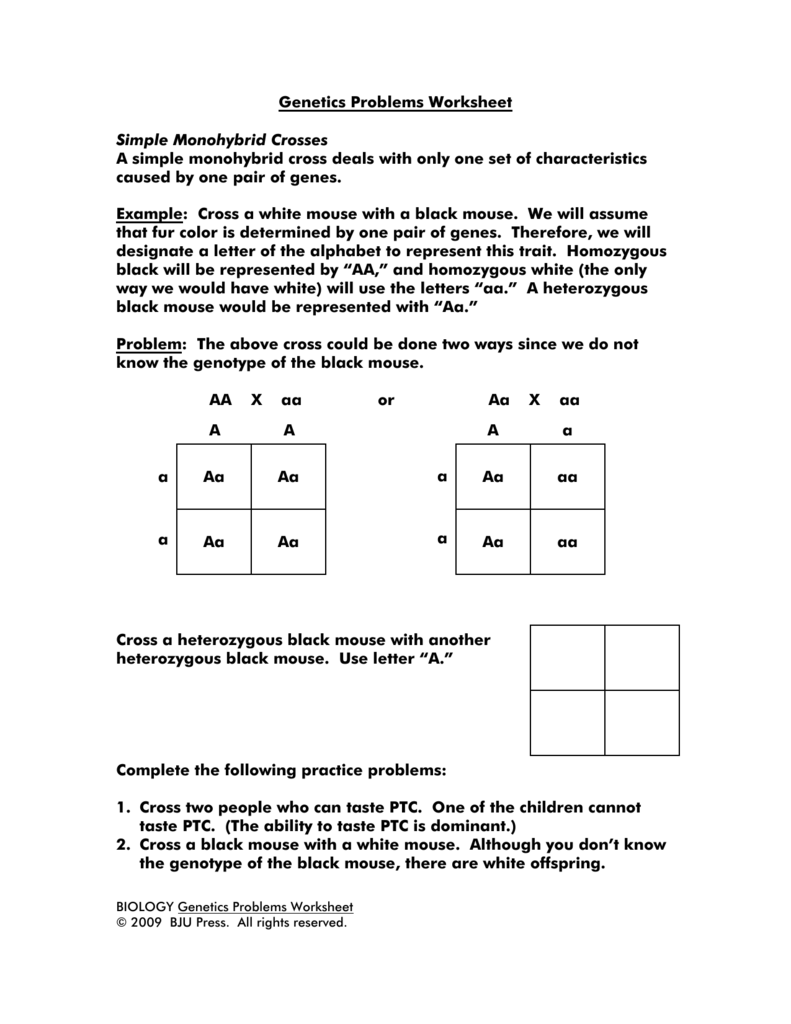Have you ever wondered how your eye color, or your pet’s fur color, is passed down through generations? The answer lies in the fascinating world of genetics, and within that world lies the concept of monohybrid crosses. Understanding monohybrid crosses can help you predict the traits of your offspring, whether you’re a plant breeder, a pet owner, or simply curious about the intricate workings of life itself.

Image: imsyaf.com
Imagine: You’ve got two plants, one with red flowers and the other with white flowers. What kind of flowers would their offspring grow? This is the essence of a monohybrid cross—a breeding experiment involving only one trait. In this article, we’ll dive deep into the concept of monohybrid crosses, explore classic examples, and provide you with a downloadable PDF to practice solving problems yourself. We’ll unravel the mysteries of genetic inheritance together!
Understanding the Building Blocks of Inheritance
Before we dive into monohybrid crosses, let’s start with the basics. Every living organism carries genetic instructions in the form of DNA. These instructions are organized into units called genes, and each gene codes for a specific trait—like eye color, flower color, or even the shape of a pea pod.
But here’s the catch: genes exist in different versions called alleles. For example, the gene for flower color can have an allele for red flowers and an allele for white flowers. We inherit one allele from our mother and one from our father. These alleles, together, determine the trait we ultimately express.
The Monohybrid Cross: A Tale of One Trait
Now, let’s focus on the star of our show—the monohybrid cross. This is a breeding experiment that examines the inheritance of just one trait. To understand its essence, let’s use our flower color example:
- Imagine you cross a homozygous dominant red-flowered plant (RR) with a homozygous recessive white-flowered plant (rr).
- ‘Homozygous’ means having two identical alleles for that trait. ‘Dominant’ means the allele masks the recessive one.
Since the red flower allele (R) is dominant, the offspring (F1 generation) will all inherit at least one R allele and will therefore have red flowers, even though they carry one recessive allele (r). Their genotype will be ‘Rr.’
The Punnett Square: Unveiling the Possibilities
A powerful tool to predict the offspring genotypes and phenotypes is the Punnett square. It’s like a grid where you combine the parental alleles to see all the possible combinations in the offspring.
Let’s use our red and white flower example again:
| R | r | ||
|---|---|---|---|
| R | RR | Rr | Red |
| r | Rr | rr | White |
As you can see, the Punnett square shows that the F1 generation (the first generation of offspring) will all have the genotype Rr, leading to red flowers.

Image: www.teacherspayteachers.com
The F2 Generation: Unveiling Hidden Traits
Things get more interesting when we cross two F1 individuals (Rr x Rr). The Punnett square shows the following possibilities:
| R | r | ||
|---|---|---|---|
| R | RR | Rr | Red |
| r | Rr | rr | White |
As you can see, the F2 generation has three possible genotypes: RR, Rr, and rr. This means that the F2 generation has a 3:1 phenotypic ratio with three quarters of the plants having red flowers (RR and Rr) and one quarter having white flowers (rr). This is known as Mendel’s Law of Segregation, which states that alleles for a trait separate during gamete formation.
Real-World Applications of Monohybrid Crosses
Monohybrid crosses have tangible applications in real life, impacting fields like:
- Agriculture: Plant breeders use monohybrid crosses to select for desirable traits like higher yield, disease resistance, or improved nutritional content in crops.
- Animal breeding: Livestock breeders can employ monohybrid crosses to breed animals with beneficial characteristics like higher milk production in cows or faster growth rate in chickens.
- Medicine: Geneticists use knowledge of monohybrid crosses to understand the inheritance patterns of genetic disorders, leading to advancements in diagnosis and treatment.
Putting Your Knowledge to the Test: Practice Problems
Want to test your understanding of monohybrid crosses? We’ve prepared a PDF with practice problems and their answers that you can download for free. Don’t worry; the questions are designed to be engaging and help you solidify your concepts.
Monohybrid Cross Problems With Answers Pdf
The Power of Monohybrid Crosses: A Gateway to Genetic Understanding
Monohybrid crosses might seem like a simple concept, but they are fundamentally important for understanding the mechanisms of inheritance. By dissecting these basic breeding experiments, we gain insight into how traits are passed from parents to offspring, enabling us to predict the genetic makeup of future generations. Whether you’re a biology enthusiast, a future geneticist, or simply someone curious about the world around you, understanding monohybrid crosses is a key to unlocking the secrets of life itself.
Remember, the world of genetics is vast and fascinating, with countless more concepts to explore. This article is just the beginning; use it as a springboard to delve deeper into this captivating field! Let us know your questions and share your experiences with monohybrid crosses in the comments below. Happy learning!






